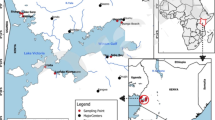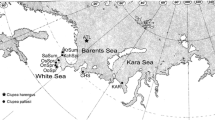Abstract
Natural hybridization may influence population fitness and responsiveness to natural selection, in particular in oceanic island systems. In previous studies, interspecific hybridization was detected between the Galápagos iguana species Amblyrhynchus cristatus and Conolophus subcristatus. Further, possible hybridization was also suggested to occur between C. subcristatus and C. marthae at Wolf Volcano on Isabela Island. In this work, we investigated the level of hybridization between C. subcristatus and C. marthae using a large set of microsatellite markers. Results indicated strong differentiation between species and, while we cannot rule out hybridization in the past, there is no evidence of ongoing hybridization between C. marthae and C. subcristatus. These findings have great importance for the design of management actions and conservation plans, in particular for the purposes of a head start program. However, because potential for hybridization may change under different environmental and demographic conditions, genetic characterization of newly marked individuals of C. marthae and C. subcristatus in Wolf Volcano should not be interrupted.




Similar content being viewed by others
Data availability
Allele frequencies and genotype data are available in the Supplementary Information.
References
Allendorf FW, Leary RF, Spruell P, Wenburg JK (2001) The problems with hybrids: setting conservation guidelines. Trends Ecol Evol 16:613–622
Anderson EC, Thompson EA (2002) A model-based method for identifying species hybrids using multilocus genetic data. Genetics 160:1217–1229
Armstrong DP, Seddon PJ (2008) Directions in reintroduction biology. Trends Ecol Evol 23:20–25
Arnold ML (2006) Evolution through genetic exchange. Oxford University Press, London
Belkhir K, Borsa P, Chikhi L, Raufaste N, Bonhomme F (2004) GENETIX 4.05, Logiciel sous windows tm pour la génétique des populations. Laboratoire Génome, Populations, Interactions, CNRS UMR 5000. Université de Montpellier II, Montpellier, France
Breuil M, Day M, Knapp CR (2010) Iguana delicatissima. In: The IUCN Red List of threatened species 2010, e.T10800A3217854
Burke JM, Arnold ML (2001) Genetics and the fitness of hybrids. Annu Rev Genet 35:31–52
Carlsson J (2008) Effects of microsatellite null alleles on assignment testing. J Hered 99:616–623
Chapius MP, Estoup A (2007) Microsatellite null alleles and estimation of population differentiation. Mol Biol Evol 24:621–631
Dąbrowski MJ, Pilot M, Kruczyk M, Żmihorski M, Umer HM, Gliwicz J (2014) Reliability assessment of null allele detection: inconsistencies between and within different methods. Mol Ecol Resour 14:361–373
Di Giambattista L (2016) Microevolutionary processes and population structure of Galápagos iguanas. Ph.D Thesis. University of Rome Tor Vergata, Rome, Italy
Dittrich-Reed DR, Fitzpatrick BM (2013) Transgressive hybrids as hopeful monsters. Evol Biol 40:1–6
Dubois A (2006) Species introductions and reintroductions, faunistic and genetic pollution: some provocative thoughts. Alytes 24:147–164
Earl DA, vonHoldt BM (2012) STRUCTURE HARVESTER: a Website and program for visualizing structure output and implementing the Evanno method. Conserv Genet Resour 4:359–361
Evanno G, Regnaut S, Goudet J (2005) Detecting the number of clusters of individuals using the software structure: a simulation study. Mol Ecol 14:2611–2620
Fabiani A, Trucchi E, Rosa S, Marquez C, Snell HL, Snell HM et al (2011) Conservation of Galápagos land iguanas: genetic monitoring and predictions of a long-term program on the island of Santa Cruz. Anim Conserv 14:419–429
Falush D, Stephens M, Pritchard JK (2003) Inference of population structure using multilocus genotype data: linked loci and correlated allele frequencies. Genetics 164:1567–1587
Fitzpatrick BM, Shaffer HB (2007) Hybrid vigor between native and introduced salamanders raises new challenges for conservation. Proc Nat Acad Sci USA 104:15793–15798
Frankham R (2005) Genetics and extinction. Biol Conserv 126:131–140
Frankham R, Ballou JD, Briscoe DA (2009) An introduction to conservation genetics, 2nd edn. Cambridge University Press, Cambridge
Gabirot M, Lopez P, Martin J (2012) Differences in chemical signal may promote reproductive isolation and cryptic speciation between Iberian wall lizard populations. Int J Evol Biol 2012:1–13
Gentile G (2012) Conolophus marthae. The IUCN Red List of Threatened Species 2012:e.T174472A1414375. https://doi.org/10.2305/IUCN.UK.2012-1.RLTS.T174472A1414375.en
Gentile G, Snell HL (2009) Conolophus marthae sp. nov. (Squamata, Iguanidae), a new species of land iguana from the Galápagos archipelago. Zootaxa 2201:1–10
Gentile G, Fabiani A, Marquez C, Snell HL, Snell HM, Tapia W et al (2009) An overlooked pink species of land iguanas in the Galápagos. Proc Nat Acad Sci USA 106:507–511
Gentile G, Marquez C, Tapia W, Izurieta A (2016) Conservation of a new flagship species: the Galápagos pink land iguana (Conolophus marthae Gentile and Snell, 2009. In: Angelici F (ed) Problematic wildlife, a cross-disciplinary approach. Springer, Cham, pp 315–336
Glaubitz JC (2004) CONVERT: a user-friendly program to reformat diploid genotypic data for commonly used population genetic software packages. Mol Ecol Notes 4:309–310
Grant PR, Grant BR (2016) Introgressive hybridization and natural selection in Darwin’s finches. Biol J Linn Soc 117:812–822
Grant PR, Grant BR, Petren K (2005) Hybridization in the recent past. Am Nat 166:56–67
Hedrick PW (2005) A standardized genetic differentiation measure. Evolution 59:1633–1638
Hedrick PW (2013) Adaptive introgression in animals: examples and comparison to new mutation and standing variation as sources of adaptive variation. Mol Ecol 22:4606–4618
Henrich T, Kalbe M (2016) The role of prezygotic isolation mechanisms in the divergence of two parasite species. BMC Evol Biol 16:245
Hoskin CJ, Higgie M, McDonald KR, Moritz C (2005) Reinforcement drives rapid allopatric speciation. Nature 437:1353–1356
Jančuchová-Lásková J, Landová E, Frynta D (2015) Are genetically distinct lizard able to hybridize? A review. Curr Zool 61:155–180
Kisel Y, Barraclough TG (2010) Speciation has a spatial scale that depends on level of gene flow. Am Nat 175:316–334
Kleindorfer S, O’Connor JA, Dudaniec RY, Myers SA, Robertson J, Sulloway FJ (2014) Species collapse via hybridization in Darwin’s tree finches. Am Nat 183:325–341
Knapp C, Breuil M, Rodrigues C, Iverson J (eds) (2014) Lesser antillean Iguana, Iguana delicatissima: conservation action plan, 2014–2016. IUCN SSC Iguana Specialist Group, Gland
Macleod A, Rodríguez A, Vences M, Orozco-Terwengel P, García C, Trillmich F, Gentile G, Caccone A, Quezada G, Steinfartz S (2015) Hybridization masks speciation in the evolutionary history of the Galápagos marine iguana. Proc R Soc B 282:20150425
Malone CL, Wheeler T, Taylor JF, Davis SK (2000) Phylogeography of the Caribbean rock iguana (Cyclura): implications for conservation and insights on the biogeographic history of the West Indies. Mol Phylogenet Evol 17:269–279
Mebert K, Jagar T, Grželj JR, Cafuta V, Luiselli L, Ostanek E et al (2015) The dynamic of coexistence: habitat sharing versus segregation patterns among three sympatric montane vipers. Biol J Linn Soc 2015:1–13
Meirmans PG, Hedrick PW (2011) Assessing population structure: FST and related measures. Mol Ecol Res 11:5–18
Moss JB, Welch ME, Burton FJ, Vallee MV, Houlcroft EW, Laaser T, Gerber GP (2018) First evidence for crossbreeding between invasive Iguana iguana and the native rock iguana (Genus Cyclura) on Little Cayman Island. Biol Invasions 20:817–823
Nei M (1972) Genetic distance between populations. Am Nat 106:283–292
Onorati M, Sancesario G, Pastore D, Bernardini S, Carrion J, Carosi M, Vignoli L, Lauro D, And Gentile G (2016) Plasma concentrations of progesterone and estradiol and the relation to reproduction in Galápagos land iguanas, Conolophus marthae and C. subcristatus (Squamata, Iguanidae). Anim Reprod Sci 172:105–113
Peakall R, Smouse PE (2012) GenAlEx 6.5: genetic analysis in Excel. Population genetic software for teaching and research—an update. Bioinformatics 28:2537–2539
Peakall R, Smouse E, Huff DR (1995) Evolutionary implications of allozyme and RAPD Variation in diploid populations of dioecious buffalograss Buchloe dactyloides. Mol Ecol 4:135–147
Petit RJ (2004) Biological invasion at the gene level. Divers Distrib 10:159–165
Pritchard JK, Stephens M, Donnelly P (2000) Inference of population structure using multilocus genotype data. Genetics 155:945–959
Pruett CL, Turner TN, Topp CM, Zagrebelny KW (2010) Divergence in an archipelago and its conservation consequences in Aleutian Island rock ptarmigan. Cons Gen 11:241–248
Rassmann K, Trillmich F, Tautz B (1997) Hybridization between Galápagos land and marine iguana (Conolophus subcristatus and Amblyrhynchus cristatus) in Plaza Sur. J Zool Lond 242:729–739
Raymond M, Rousset F (1995) GENEPOP Version 1.2: population genetic software for exact tests and ecumenicism. J Hered 86:248–249
Rhymer JK, Simberloff D (1996) Extinction by hybridization and introgression. Annu Rev Ecol Syst 27:83–109
Rivas LR (1964) A reinterpretation of the concepts “Sympatric” and “Allopatric” with proposal of the additional terms “Syntopic” and “Allotopic”. Syst Biol 13:42–43
Rosa SFP, Monteyne D, Milinkovitch MC (2009) Development of 10 highly-polimorphic microsatellite markers in the vulnerable Galápagos land iguana (genus Conolophus). Mol Ecol Res 9:376–379
Schwartz MK, Pilgrim KL, McKelvey KS, Lindquist EL, Claar JJ, Loch S, Ruggiero LF (2004) Hybridization between Canada lynx and bobcats: genetic results and management implications. Conserv Genet 5:349–355
Schwenk K, Brede N, Streit B (2008) Introduction. extent, processes and evolutionary impact of interspecific hybridization in animals. Philos Trans R Soc B 363:2805–2811
Servedio MR (2001) Beyond reinforcement: the evolution of premating isolation by direct selection on preference and postmating, prezygotic incompatibilities. Evolution 55:1909–1920
Steinfartz S, Caccone A (2006) A Set of highly discriminating microsatellite loci for the Galápagos marine iguana Amblyrhynchus cristatus. Mol Ecol Notes 6:927–929
Szpiech ZA, Rosenberg NA (2011) On the size distribution of private microsatellite alleles. Theor Popul Biol 80:100–113
Tzika A, Rosa S, Marquez C, Snell H, Snell H, Tapia W, Gentile G, Milinkovitch M (2008) Population genetics of Galápagos land iguana (genus Conolophus) remnant populations. Mol Ecol 17:4943–4952
Van Oosterhout C, Hutchinson WS, Wills DPM, Shipley P (2004) MICRO-CHECKER: software for identifying and correcting genotyping errors in microsatellite data. Mol Ecol Notes 4:535–538
van den Burg MP, Meirmans PG, van Wagensveld TP, Kluskens B, Madden H, Welch ME, Breeuwer JAJ (2018) The Lesser Antillean iguana (Iguana delicatissima) on St. Eustatius: genetically depauperate and threatened by ongoing hybridization. J Hered 109:426–437
Weir BS, Cockerham CC (1984) Estimating F-statistic for the analysis of population structure. Evolution 38:1358–1370
Wilson A, Arcese P, Keller LF, Pruett CL, Winker K, Patten MA et al (2009) The contribution of island populations to in situ genetic conservation. Conserv Genet 10:419–430
Wright S (1969) Evolution and the genetics of populations, vol 2. The theory of gene frequencies. University of Chicago Press, Chicago
Acknowledgements
We gratefully thank the park rangers of the Galápagos National Park for their invaluable support and friendship. We thank Michel Milinkovitch for kindly providing data. We thank Philip Hedrick and Mark Welch for their valuable criticism. This work is in the frame of a long term partnership between the University Tor Vergata and the Galápagos National Park Directorate, aimed at conservation of Galápagos iguanas. This work was supported by the Mohamed bin Zayed Species Conservation Fund with a grant to GG (Project No. 12254183; https://www.speciesconservation.org/case-studies-projects/galapagos-pink-land-iguana/4183).
Author information
Authors and Affiliations
Corresponding author
Ethics declarations
Conflict of interest
Authors declare no conflict of interest.
Ethical approval
Animal manipulation and blood sampling were performed according to a protocol that minimized animal stress, in accordance with the European Community guidelines and with the approval of the Galápagos National Park Directorate. Samples were exported and imported under the CITES permits 101/BG and IT/IM/2015/MCE/01711.
Electronic supplementary material
Below is the link to the electronic supplementary material.
Rights and permissions
About this article
Cite this article
Di Giambattista, L., Fulvo, A., Fabiani, A. et al. Molecular data exclude current hybridization between iguanas Conolophus marthae and C. subcristatus on Wolf Volcano (Galápagos Islands). Conserv Genet 19, 1461–1469 (2018). https://doi.org/10.1007/s10592-018-1114-3
Received:
Accepted:
Published:
Issue Date:
DOI: https://doi.org/10.1007/s10592-018-1114-3




